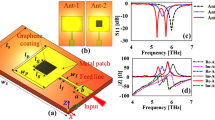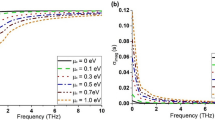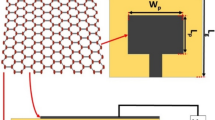Abstract
This research work reports a technique using which the antenna response can be reformed either with or without band notch characteristics. A metallic antenna is implemented for attaining the wideband response in terahertz (THz) frequency covering 8.55–12.4 THz. The radiator is inscribed with the slots in it for attaining the band notch feature in antenna in the range 8.62–9.53 THz over the covering frequency range of 8.15–14.56 THz. The created slots in the antenna radiator create the capacitive effect leading to the filtering attributes. Slots are filled with the graphene material for acquiring the reformation capability in antenna. The surface conductivity of graphene is set at the higher value for removal of the formed capacitive edges and hence the field confinement from antenna radiator which mitigates the created filtering attributes. The lower value of the surface conductivity of graphene leads to reform the capacitive effect and hence the field confinement and the filtering characteristics. The antenna provides the gain in the range of 4–7 dBi with the radiation efficiency of more than 90%.







Similar content being viewed by others
Availability of Data and Materials
There is no associated data with this research work.
References
Wang R, Ren XG, Yan Z, Jiang LJ, Sha WEI, Shan GC (2019) Graphene based functional devices: A short review. Front Phys 14:1. https://doi.org/10.1007/s11467-018-0859-y
Varshney G (2020) Reconfigurable graphene antenna for THz applications: a mode conversion approach. Nanotechnology 31(13):11. https://doi.org/10.1088/1361-6528/ab60cc
Varshney G, Giri P (2021) Bipolar charge trapping for absorption enhancement in a graphene-based ultrathin dual-band terahertz biosensor. Nanoscale Adv 3(20):5813–5822. https://doi.org/10.1039/d1na00388g
Sensale-Rodriguez B et al (2012) Broadband graphene terahertz modulators enabled by intraband transitions. Nat Commun 3:780. https://doi.org/10.1038/ncomms1787
Khan MS, Varshney G, Giri P (2021) Altering the multimodal resonance in ultrathin silicon ring for tunable THz biosensing. IEEE Trans Nanobiosci 20(4):488–496. https://doi.org/10.1109/TNB.2021.3105561
Nejat M, Nozhat N (2019) Ultrasensitive THz refractive index sensor based on a controllable perfect MTM absorber. IEEE Sens J 19(22):10490–10497. https://doi.org/10.1109/JSEN.2019.2931057
Varshney G (2020) Tunable terahertz dielectric resonator antenna. SILICON 13(2021):1907–1915. https://doi.org/10.1007/s12633-020-00577-0
Vishwanath, Babu R, Sharma V, Sahana BC, Varshney G (2023) Controlling the resonant modes / bandwidth using graphene strip and isolation enhancement in a two - port THz MIMO. Opt Quantum Electron 55:1–15. https://doi.org/10.1007/s11082-023-04970-y
Lee KF, Tong KF (2012) Microstrip patch antennasbasic characteristics and some recent advances. Proc IEEE 100(7):2169–2180. https://doi.org/10.1109/JPROC.2012.2183829
Losada V, Boix RR, Horno M (1999) Resonant modes of circular microstrip patches in multilayered substrates. IEEE Trans Microw Theory Tech 47(4):488–498. https://doi.org/10.1109/22.754883
Michalski KA, Zheng D (1992) Analysis of microstrip resonators of arbitrary shape. IEEE Trans Microw Theory Tech 40(1):112–119. https://doi.org/10.1109/22.108330
Aqlan B, Himdi M, Vettikalladi H, Le-Coq L (2021) A circularly polarized sub-terahertz antenna with low-profile and high-gain for 6G wireless communication systems. IEEE Access PP:1–1. https://doi.org/10.1109/access.2021.3109161
Abohmra A et al (2021) An ultrawideband microfabricated gold-based antenna array for terahertz communication. IEEE Antennas Wirel Propag Lett. 14(8):1–1. https://doi.org/10.1109/lawp.2021.3072562
Alibakhshikenari M et al (2021) High-isolation antenna array using SIW and realized with a graphene layer for sub-terahertz wireless applications. Sci Rep 11(1):1–14. https://doi.org/10.1038/s41598-021-87712-y
Zak A et al (2014) Antenna-integrated 0.6 THz FET direct detectors based on CVD graphene. Nano Lett 14(10):5834–5838. https://doi.org/10.1021/nl5027309
Moradi K, Pourziad A, Nikmehr S (2021) A frequency reconfigurable microstrip antenna based on graphene in terahertz regime. Optik (Stuttg) 228(December 2020):166201. https://doi.org/10.1016/j.ijleo.2020.166201
Naik KK, Suman M, Rao EK (2021) Design of complementary split ring resonators on elliptical patch antenna with enhanced gain for terahertz applications. Optik (Stuttg) 243:167434. https://doi.org/10.1016/j.ijleo.2021.167434
Krishna CM, Das S, Nella A, Lakrit S, Madhav BTP (2021) A micro-sized rhombus-shaped thz antenna for high-speed short-range wireless communication applications. Plasmonics 16(0123456789):2167–2177. https://doi.org/10.1007/s11468-021-01472-z
Das V, Rawat S (2021) Design and analysis of monopole planar antenna with defected ground plane for WBAN applications in terahertz range. Optik (Stuttg) 248:168187. https://doi.org/10.1016/j.ijleo.2021.168187
Kiani N, Tavakkol Hamedani F, Rezaei P, Jafari Chashmi M, Danaie M (2020) Polarization controling approach in reconfigurable microstrip graphene-based antenna. Optik (Stuttg) 203:163942. https://doi.org/10.1016/j.ijleo.2019.163942
Kiani N, Tavakkol Hamedani F, Rezaei P (2022) Realization of polarization adjusting in reconfigurable graphene-based microstrip antenna by adding leaf-shaped patch. Micro Nanostruct 168(May):207322. https://doi.org/10.1016/j.micrna.2022.207322
Sharma T, Varshney G, Yaduvanshi RS, Vashishath M (2022) Modified Koch borderline monopole antenna for THz regime. Opt Quantum Electron 54(5):1–16. https://doi.org/10.1007/s11082-022-03687-8
Sharma T, Varshney G, Vashishath RSYM (2020) Obtaining the tunable band-notch in ultrawideband THz antenna using graphene nanoribbons. Opt Eng 59(4):047103–1–047103–11. https://doi.org/10.1117/1.OE.59.4.047103
Srivastava K, Varshney G, Singh R (2021) Compact ultra-wideband monopole antenna with tunable notch bandwidth/frequency ratio. Frequenz 75(7–8):289–300. https://doi.org/10.1515/freq-2020-0173
Varshney G (2020) Ultra-Wideband Antenna Using Graphite Disk Resonator for THz. Superlattices Microstruct. https://doi.org/10.1016/j.spmi.2020.106480
Forsythe RE, Bohlander RA, Butterworth JC (1991) An experimental 225 GHZ pulsed coherent radar. IEEE Trans Microw Theory Tech 39(3):555–562. https://doi.org/10.1109/22.75300
Kumar D, Sharma A, Arora A, Giri P, Varshney G (2022) Terahertz antenna with tunable filtering characteristics. Opt Quantum Electron 54(12):1–12. https://doi.org/10.1007/s11082-022-04281-8
Khan MS, Priya BJ, Aishika R, Varshney G (2023) Implementing the circularly polarized THz antenna with tunable filtering characteristics. Results Opt 11:100377. https://doi.org/10.1016/j.rio.2023.100377
Ali MF, Jiya T, Singh KR, Varshney G (2023) Terahertz antenna with controllable and tunable filtering characteristics. Micro Nano Struct 174:207476. https://doi.org/10.1016/j.micrna.2022.207476
Ali MF, Jawed Z, Raj V, Varshney G (2022) Terahertz antenna with tunable filtering. Appl Opt 61:36. https://doi.org/10.1007/s11082-022-04281-8
Kumar D et al (2022) Terahertz ultra-wideband antenna with tunable band-notch creation using resonant/non-resonant graphene loop. Opt Eng 61(10):107106. https://doi.org/10.1117/1.oe.61.10.107106
Kiani N, Tavakol Hamedani F, Rezaei P (2022) Implementation of a reconfigurable miniaturized graphene-based SIW antenna for THz applications. Micro and Nanostruct 169(April):207365. https://doi.org/10.1016/j.micrna.2022.207365
Singh R, Varshney G (2023) Isolation enhancement technique in a dual-band THz MIMO antenna with single radiator. Opt Quantum Electron 55(539):1–17. https://doi.org/10.1007/s11082-023-04811-y
Suñé GR (2008) Electron beam lithography for Nanofabrication, in Nanomaterials, Nanostructures, and Nanotechnologie (January), Institut de Microelectrònica de Barcelona. https://www.tdx.cat/bitstream/handle/10803/3404/grs1de2.pdf;jsessionid=9967A33ED91DCFDCB1BD1F860B231005?sequence=1
Hanson GW (2008) Dyadic green’s functions for an anisotropic, non-local model of biased graphene. IEEE Trans Antennas Propag 56(3):747–757. https://doi.org/10.1109/TAP.2008.917005
Samanta G, Mitra D (2018) Wideband THz antenna using graphene based tunable circular reactive impedance substrate. Optik (Stuttg) 158:1080–1087. https://doi.org/10.1016/j.ijleo.2017.12.197
Varshney G, Verma A, Pandey VS, Yaduvanshi RS, Bala R (2018) A proximity coupleld wideband graphene antenna with the generation of higher order TM modes for THz applications. Opt Mater (Amst) 85:456–463
Tripathi SK, Kumar M, Kumar A (2019) Graphene based tunable and wideband terahertz antenna for wireless network communication. Wirel Networks 25(7):4371–4381. https://doi.org/10.1007/s11276-019-02101-8
Shamim SM, Das S, Hossain MA, Madhav BTP (2021) Investigations on graphene-based ultra-wideband (UWB) microstrip.pdf. Plasmonics 1–7
Nickpay MR, Danaie M, Shahzadi A (2019) Wideband rectangular double-ring nanoribbon graphene-based antenna for terahertz communications. IETE J Res 68(3):1625–1634. https://doi.org/10.1080/03772063.2019.1661801
Author information
Authors and Affiliations
Contributions
Salman Khan and Amarnath have simulated the antenna and prepared the manuscript, Ankit Gupta has supervised and written the research work, and Gaurav Varshney has developed the idea and wrote the manuscript.
Corresponding author
Ethics declarations
Ethics Approval
Not applicable.
Competing Interests
There is no competing interest among the authors.
Additional information
Publisher's Note
Springer Nature remains neutral with regard to jurisdictional claims in published maps and institutional affiliations.
Rights and permissions
Springer Nature or its licensor (e.g. a society or other partner) holds exclusive rights to this article under a publishing agreement with the author(s) or other rightsholder(s); author self-archiving of the accepted manuscript version of this article is solely governed by the terms of such publishing agreement and applicable law.
About this article
Cite this article
Khan, M.S., Kumar, A., Gupta, A. et al. Reforming the Capacitive Edges in the Plasmonic Radiator of THz Antenna Using Graphene for Controllable Notched Band. Plasmonics 18, 2001–2008 (2023). https://doi.org/10.1007/s11468-023-01921-x
Received:
Accepted:
Published:
Issue Date:
DOI: https://doi.org/10.1007/s11468-023-01921-x




